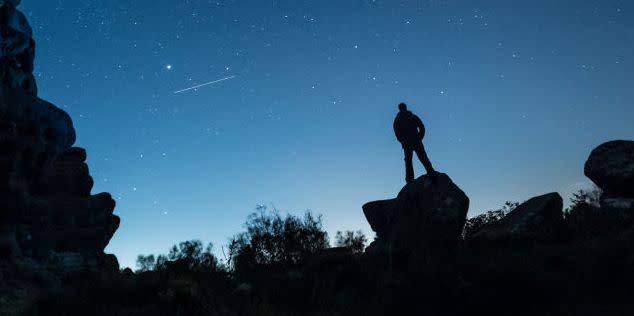One of the Most Beautiful Meteor Showers of the Year Will Peak This Week

The 2020 Orionid meteor shower lasts from October 2 to November 7, peaking on the morning of Wednesday, October 21.
The show is “one of the most beautiful showers of the year,” according to NASA.
Later this month, a super-rare Halloween Blue Moon will also illuminate the sky.
October is a busy time for sky-watchers—between an unusually late Harvest Moon and an ultra-rare Halloween Blue Moon, one of the most intense meteor showers of the year, the Orionids, will be visible for much of the month. For fans of spooky season (or space), it’s a must watch.
This year’s Orionid meteor shower lasts from October 2 to November 7, and it’s expected to peak in the early hours of Wednesday, October 21, according to the American Meteor Society. Each night, the shower should be visible from about 11:30 p.m. to 5:40 a.m., with best viewing from 4:40 to 5:40 a.m., per the Griffith Observatory.
Named for the constellation Orion, where the meteors appear in the sky, the shower is widely considered to be one of the most beautiful of the year. “Orionid meteors are known for their brightness and for their speed,” NASA explains. Because of their speed, these meteors leave both “trains” (glowing trails that can last for minutes) and explode into “fireballs” (exactly what that sounds like).
The Orionids are actually debris left behind by Halley’s Comet, which last appeared in 1986 and won’t swing around again until 2061, NASA reports. They become shooting stars when Earth passes through the debris, causing them to enter our atmosphere and disintegrate in a fiery spectacle.
Thanks to an early moonset, viewing conditions for the Orionids are ideal this year. For the best chance of seeing a shooting star, try to find an outdoor spot with as little artificial light as possible. Once you’re settled in, lay flat on your back, focus your gaze straight up, and be patient—despite the name, NASA says, the meteors are visible throughout the sky.
Support from readers like you helps us do our best work. Go here to subscribe to Prevention and get 12 FREE gifts. And sign up for our FREE newsletter here for daily health, nutrition, and fitness advice.
You Might Also Like
